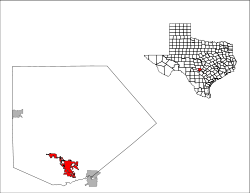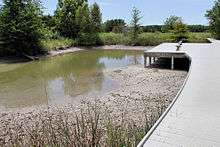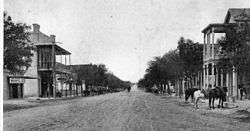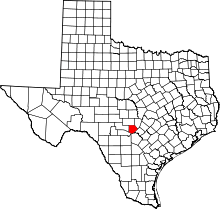Boerne, Texas
| Boerne, Texas | |
|---|---|
|
Main Street in Boerne, Texas ca 1890-1900 | |
|
Location of Boerne, Texas | |
 | |
| Country |
|
| State |
|
| Counties | Kendall County |
| Settled | 1849 |
| Government | |
| • Type | Council-Manager |
| • City Council |
|
| • City Manager | Ronald Bowman |
| Population (2010) | |
| • Total | 10,471 |
| Website |
www |
Boerne (/ˈbɜːrni/ BUR-nee) is a city in and the county seat of Kendall County, Texas, United States,[1] within the Texas Hill Country. Boerne was named in honor of a Jewish-German author and publicist. The population of Boerne was 10,471 at the 2010 census. The city is noted for the landmark U.S. Supreme Court case City of Boerne v. Flores. Founded in 1849 as Tusculum, the name was changed to Boerne when the town was platted in 1852.
Boerne is part of the San Antonio–New Braunfels Metropolitan Statistical Area.
Boerne is the home of the Guadalupe Valley Poetry Celebration, a regional poetry festival that benefits the Boerne Public Library.
History
Boerne came into being as an offshoot of the Texas Hill Country Free Thinker Latin Settlements, resulting from the Revolutions of 1848 in the German states. Those who came were Forty-Eighters, intellectual liberal abolitionists who enjoyed conversing in Latin and who believed in utopian ideals that guaranteed basic human rights to all.[2] They reveled in passionate conversations about science, philosophy, literature, and music[3] The Free Thinkers first settled Castell,[4] Bettina,[5] Leningen.[6] and Schoenburg in Llano County. These experimental communities were supported by the Adelsverein[7] for one year. The communities eventually failed due to lack of finances after the Adelsverein funding expired, and conflict of structure and authorities. Many of the pioneers from these communities moved to Sisterdale, Boerne and Comfort.[8]
In 1849, a group of Free Thinker German colonists from Bettina camped on the north side of Cibolo Creek, about a mile west of the site of present Boerne. They named their new community after Cicero's Tusculum home in ancient Rome. In 1852, John James and Gustav Theissen,[2] who helped settle Sisterdale, platted the townsite, renamed it in honor of German author Karl Ludwig Börne,[9][10] with the Anglicized spelling of Boerne. The town was not incorporated until 1909. August Staffell[11] was the original postmaster in 1856.
The 1870 limestone courthouse, second oldest in Texas, was designed by architects Philip Zoeller and J. F. Stendebach, and stands directly across the street from the current 1998 courthouse designed by architects Rehler Vaughn & Koone, Inc.[12]
In March 1887, the San Antonio and Aransas Pass Railway came to town. The coming of the railroad was an economic boost of some magnitude, and it created better conditions for the area.[13]
In the late 1870s, retired British army officers, including Glynn Turquand and Captain Egremont Shearburn, played one of the first polo matches in the United States in Boerne.[14] The polo ground is still visible on Balcones Ranch, bought by Captain Turquand in 1878.[14]
Boerne's robust environment encouraged the health resort industry. Sisters of the Incarnate Word founded the St. Mary's Sanitarium in 1896 for pulmonary patients;[15] Dr. W.E. Wright contracted with the Veterans Administration in 1919 to provide care for World War I veterans suffering from lung ailments;[16] the William L. Sill Tuberculosis Resort operated northwest of Boerne;[17] and Mrs. Adolph (Emilie) Lex opened her home to recovering patients, eventually converting two rooms into operating rooms.[18]
Karl Degener organized the Boerne Gesang Verein (singing club) and the Boerne Village Band[19] in 1860. The family and descendants of Sisterdale resident Baron Ottomar von Behr have included three generations of directors of the Boerne Village Band, and four generations of musicians.[20] The band is billed as "Oldest Continuously Organized German Band in the World outside Germany", and in 1998[21] the Federal Republic of Germany recognized the Boerne Village Band for its contribution to the German heritage in Texas and America.
Darmstadt Society of Forty
Some of the early settlers in Boerne migrated from the collapsed Fisher-Miller Land Grant experimental colonies of the Darmstadt Society of Forty.
Geography
Boerne is located at 29°47′40″N 98°43′53″W / 29.794445°N 98.731483°WCoordinates: 29°47′40″N 98°43′53″W / 29.794445°N 98.731483°W.[22] According to the United States Census Bureau, the city has a total area of 6.1 square miles (16 km2), of which 5.8 square miles (15 km2) is land and 0.3 square miles (0.78 km2) (4.74%) is water.
The town is 30 miles (48 km) northwest of Downtown San Antonio.
Two of Texas' seven show caves are located in Boerne: Cave Without a Name and Cascade Caverns. They are both actively growing limestone solution caves.
Climate
The climate in this area is characterized by hot, humid summers and generally mild to cool winters. According to the Köppen Climate Classification system, Boerne has a humid subtropical climate, abbreviated "Cfa" on climate maps.[23]
Demographics
| Historical population | |||
|---|---|---|---|
| Census | Pop. | %± | |
| 1870 | 250 | — | |
| 1880 | 346 | 38.4% | |
| 1890 | 433 | 25.1% | |
| 1900 | 800 | 84.8% | |
| 1910 | 886 | 10.8% | |
| 1920 | 1,153 | 30.1% | |
| 1930 | 1,117 | −3.1% | |
| 1940 | 1,271 | 13.8% | |
| 1950 | 1,802 | 41.8% | |
| 1960 | 2,169 | 20.4% | |
| 1970 | 2,432 | 12.1% | |
| 1980 | 3,229 | 32.8% | |
| 1990 | 4,274 | 32.4% | |
| 2000 | 6,178 | 44.5% | |
| 2010 | 10,471 | 69.5% | |
| Est. 2015 | 13,674 | [24] | 30.6% |
As of the census[26] of 2000, there were 6,178 people, 2,292 households, and 1,613 families residing in the city. The population density was 1,061.1 people per square mile (409.9/km2). There were 2,466 housing units at an average density of 423.5 per square mile (163.6/km2). The racial makeup of the city was 94.76% White, 0.36% African American, 0.37% Native American, 0.16% Asian, 0.02% Pacific Islander, 3.29% from other races, and 1.05% from two or more races. Hispanic or Latino of any race were 19.44% of the population.
There were 2,292 households out of which 36.0% had children under the age of 18 living with them, 57.0% were married couples living together, 10.8% had a female householder with no husband present, and 29.6% were non-families. 25.7% of all households were made up of individuals and 13.4% had someone living alone who was 65 years of age or older. The average household size was 2.56 and the average family size was 3.10.
In the city the population was spread out with 26.0% under the age of 18, 6.7% from 18 to 24, 26.7% from 25 to 44, 23.0% from 45 to 64, and 17.6% who were 65 years of age or older. The median age was 39 years. For every 100 females there were 84.9 males. For every 100 females age 18 and over, there were 80.1 males.
The median income for a household in the city was $80,500 and the median income for a family was $50,903. Males had a median income of $35,039 versus $25,773 for females. The per capita income for the city was $23,251. About 6.5% of families and 9.8% of the population were below the poverty line, including 14.5% of those under age 18 and 7.6% of those age 65 or over.
Attractions

Hill Country Mile
Created in the early 2010s, the Hill Country Mile is a 1.1 mile long walking path following River Road Park and historic Main Street.[27] The path was created as a catalyst to unify and preserve the rich cultural identity of downtown Boerne. It was also created to increase and foster economic growth through downtown shopping and culture centers.
Cibolo Nature Center
Cibolo Nature Center (CNC) comprises over 100 acres of Hill Country trails and wilderness. The center was first opened to the public on Earth Day in 1990 after founder Carolyn Chipman Evans urged the City of Boerne to preserve marshland around Boerne City Park. CNC is maintained through a 501c3 non-profit organization called The Friends of the Cibolo Wilderness. Trails are open every day from 8 a.m. until 5 p.m. City Park is in a unique natural setting as it shares a border with Cibolo Creek.[28]
Nearby attractions
San Antonio is only 15 minutes away and is home to attractions such as Fiesta Texas, Sea World, the Alamo, the River Walk, La Cantera, and the Rim.
Notable people
- Grace Phipps – actress; Fright Night (2011), The Nine Lives of Chloe King (2011), The Vampire Diaries (2012), Teen Beach Movie (2013), and Teen Beach 2 (2015).
- Michelle Beadle – TV sports personality
- Maggie Lindemann – singer/songwriter, social media star
- Jimmy Walker (golfer) – PGA Tour Golfer
- Cheryl Ladd - actress; "Charlie's Angels" (1977-1981)[29]
See also
References
- ↑ "Find a County". National Association of Counties. Archived from the original on 2011-05-31. Retrieved 2011-06-07.
- 1 2 Scharf, Edwin E. "Freethinkers of the Early Texas Hill Country". Freethinkers Association of Central Texas. Retrieved 11 May 2010. Freethinkers Association of Central Texas
- ↑ Kennedy, Ira. "German Intellectuals on the Texas Frontier". TexFiles. Retrieved 11 May 2010. TexFiles
- ↑ "Castell, Texas". Texas Escapes - Blueprints For Travel, LLC. Retrieved 11 May 2010. Texas Escapes - Blueprints For Travel, LLC.
- ↑ "Bettina, Texas - Vanished Sister to Castell". Castell, Texas. Retrieved 11 May 2010.
- ↑ Brister, Louis E.: Leiningen, Prince Carl from the Handbook of Texas Online. Retrieved 30 April 2010. Texas State Historical Association
- ↑ Brister, Louis E.: Adelsverein from the Handbook of Texas Online. Retrieved 11 May 2010. Texas State Historical Association
- ↑ Scharf, Edwin E. "Freethinkers of the Early Texas Hill Country". Free Thinkers Association of Texas. Retrieved 11 May 2010.
- ↑ "Cimetière du Père Lachaise, Grave of Karl Ludwig Börne". Find A Grave. Retrieved 11 May 2010.
- ↑ "Börne, Karl Ludwig". Jewish Encyclopedia. Retrieved 11 May 2010.
- ↑ "Boerne Postmasters". Jim Wheat. Retrieved 11 May 2010.Jim Wheat
- ↑ "Kendall County Courthouses". Texas Escapes - Blueprints For Travel, LLC. Retrieved 11 May 2010. Texas Escapes - Blueprints For Travel, LLC.
- ↑ Boerne and the Railroad http://www.txtransportationmuseum.org/history-boerne.php
- 1 2 Horace A. Laffaye, Polo in Britain: A History, Jefferson, North Carolina: McFarland & Company, 2012, p. 69
- ↑ "St. Mary's Sanitarium". Kendall County TxGenWeb Project. Retrieved 11 May 2010.
- ↑ "Dr. Wright's Sanitorium". Kendall County TxGenWeb Project. Retrieved 11 May 2010.
- ↑ "William L. Sill Tuberculosis Resort". Kendall County TxGenWeb Project. Retrieved 11 May 2010.
- ↑ "Lex Sanitarium". Kendall County TxGenWeb Project. Retrieved 11 May 2010.
- ↑ "Boerne Village Band". Texas Music History Online. Retrieved 11 May 2010. Texas Music History Online
- ↑ von Behr musicians from the Handbook of Texas Online. Retrieved 11 May 2010. Texas State Historical Association
- ↑ "Boerne Village Band". TKendall County TxGenWeb Project. Retrieved 11 May 2010. Texas Music History Online
- ↑ "US Gazetteer files: 2010, 2000, and 1990". United States Census Bureau. 2011-02-12. Retrieved 2011-04-23.
- ↑ Climate Summary for Boerne, Texas
- ↑ "Annual Estimates of the Resident Population for Incorporated Places: April 1, 2010 to July 1, 2015". Retrieved July 2, 2016.
- ↑ "Census of Population and Housing". Census.gov. Archived from the original on May 11, 2015. Retrieved June 4, 2015.
- ↑ "American FactFinder". United States Census Bureau. Archived from the original on 2013-09-11. Retrieved 2008-01-31.
- ↑ "Hill Country Mile". Visit Boerne. Boerne Convention & Visitor's Bureau.
- ↑ "Homepage". Cibolo Nature Center & Farm.
- ↑ http://lifeafter50.com/news/2014/feb/04/cheryl-ladd-and-brian-russell-one-window-two-refle/?page=3
External links
| Wikimedia Commons has media related to Boerne, Texas. |
- City of Boerne
- Boerne Chamber of Commerce
- Boerne Berges Fest
- Boerne Convention & Visitors Bureau
- MainStreetBoerne.com
- Boerne Public Library
- Cascade Caverns
- Cibolo Nature Center
- Boerne from the Handbook of Texas Online


